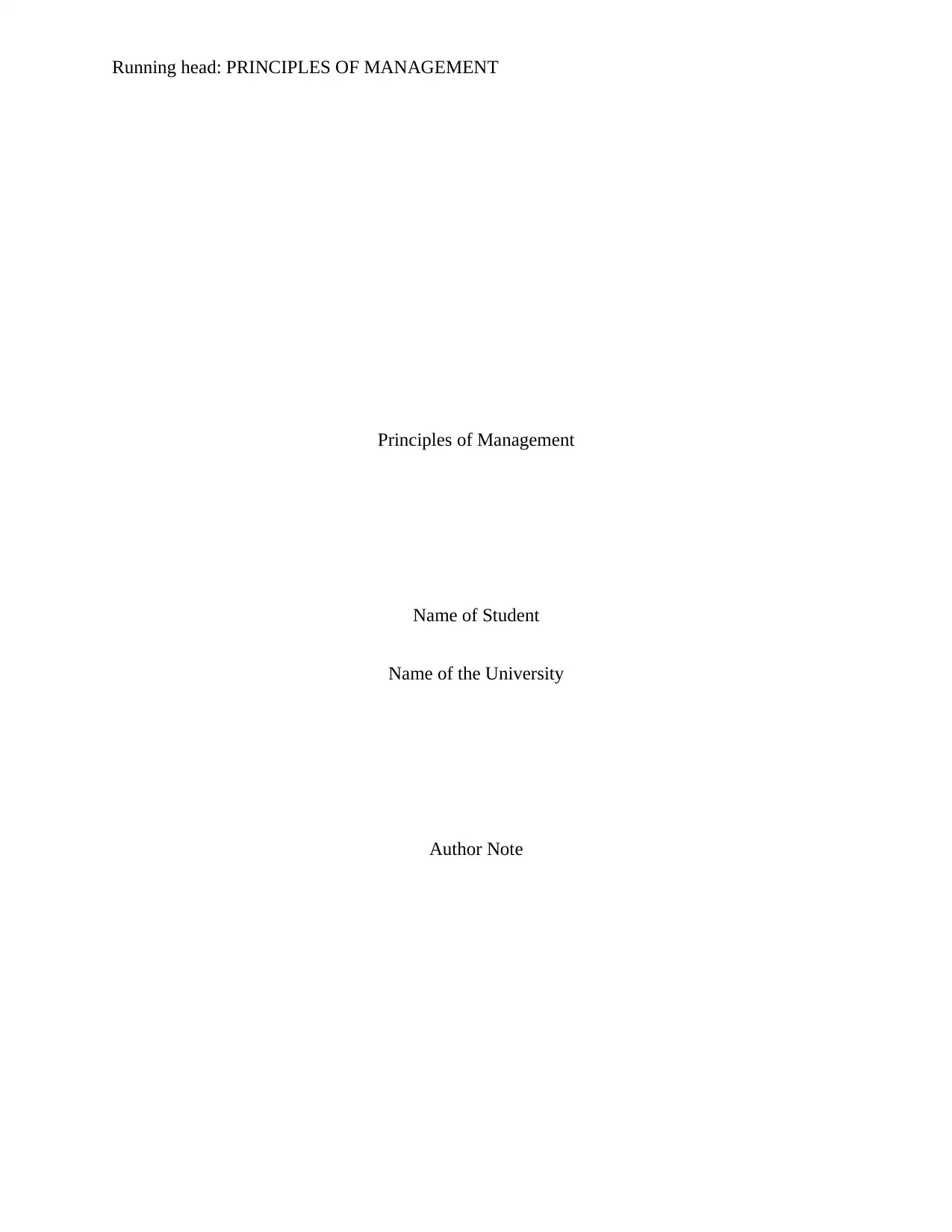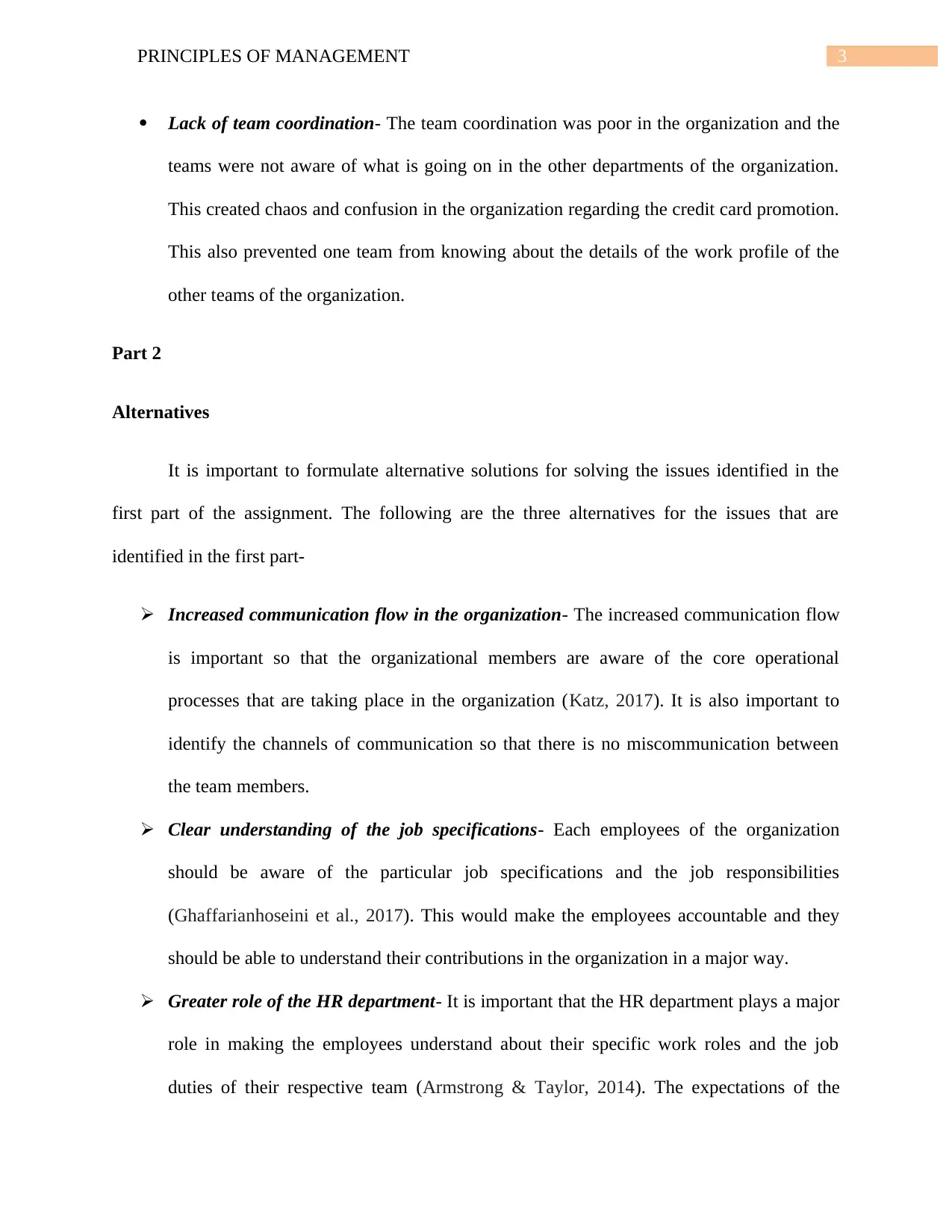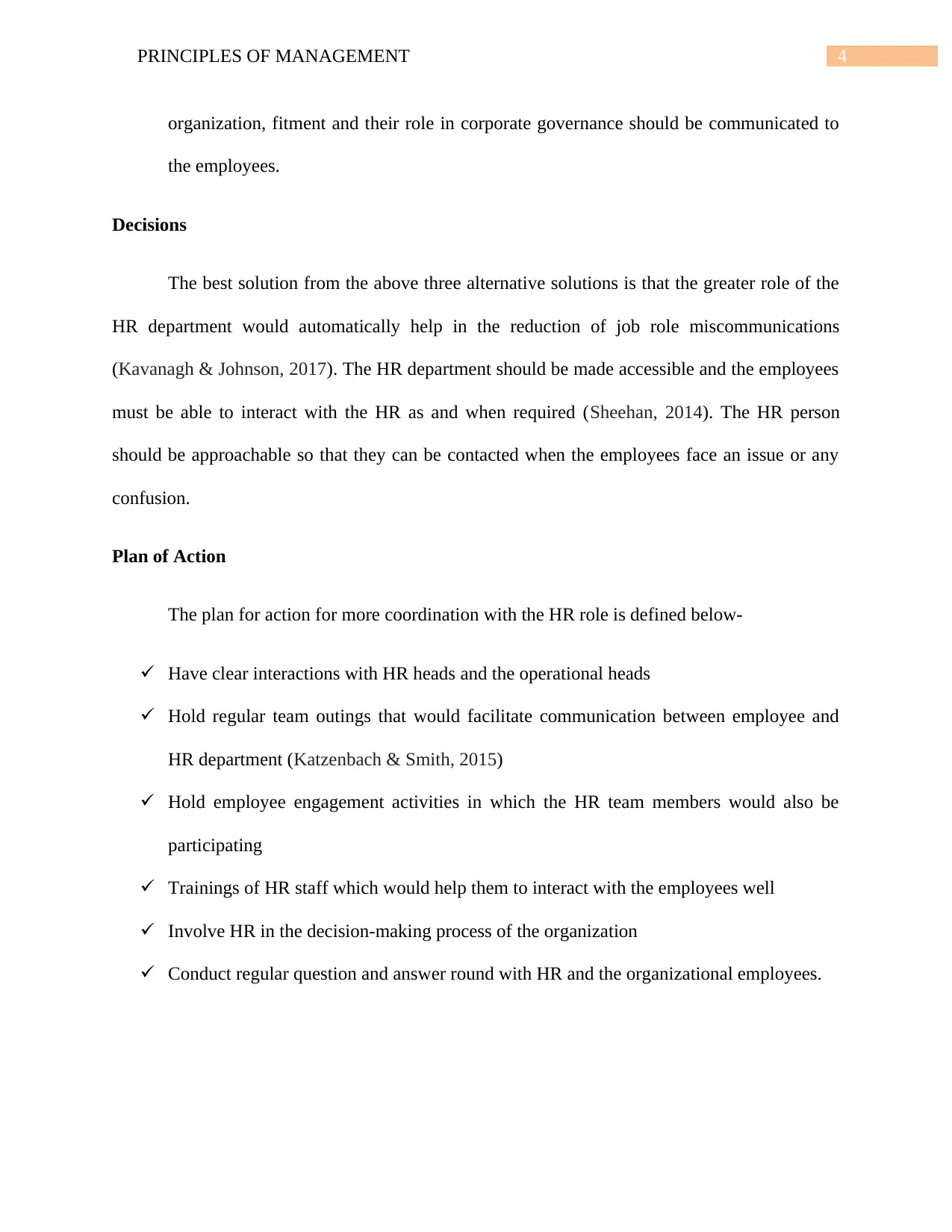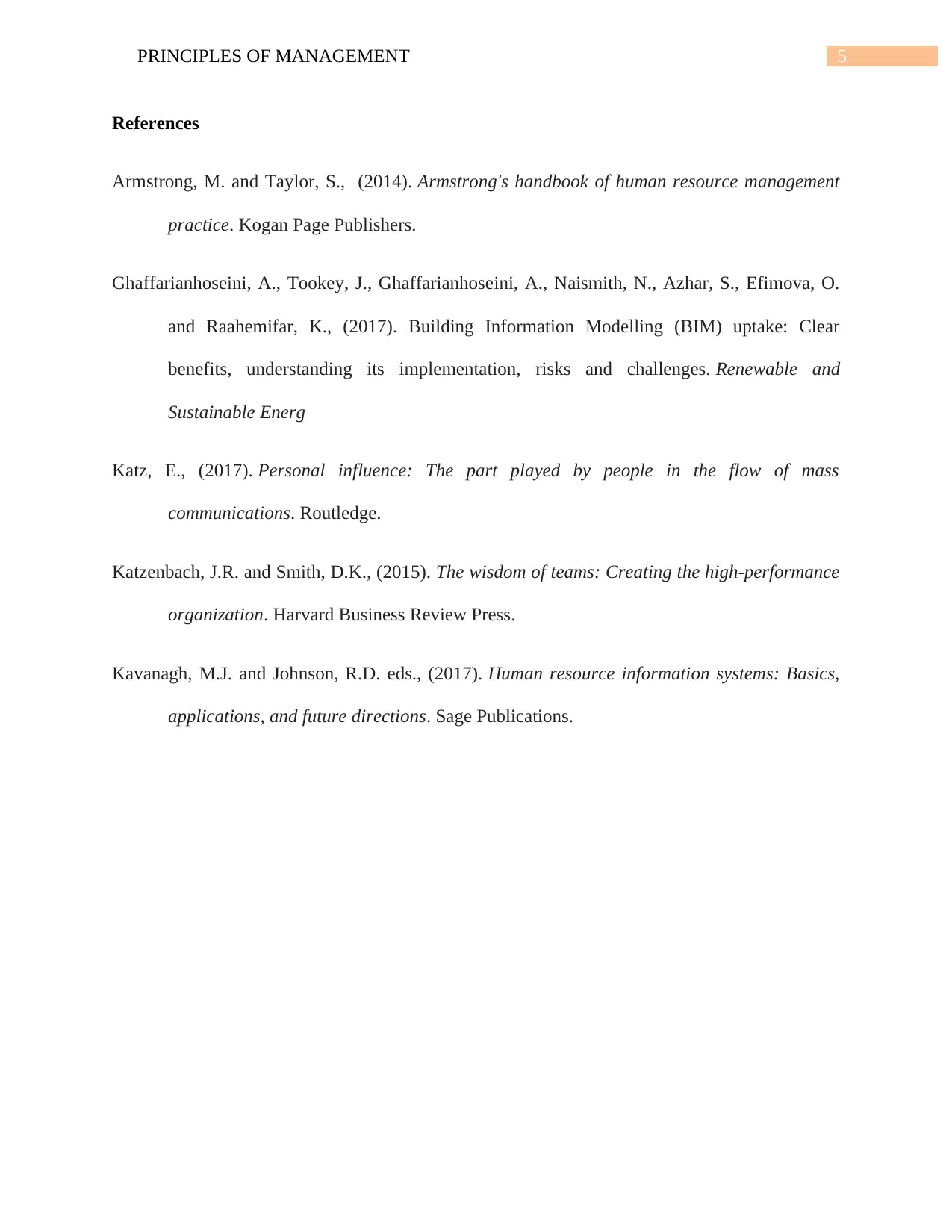Principles of Management: DHP Stores Inc. Case Study Analysis
VerifiedAdded on 2020/05/08
|6
|1203
|40
Case Study
AI Summary
This case study focuses on DHP Stores Inc., examining an organizational issue stemming from a lack of visible marketing campaigns for a new credit card promotion. The analysis delves into the symptoms of inadequate promotional content, reduced employee enthusiasm, and unclear job roles between marketing and operations. The causes are identified as unclear job roles, HR department shortcomings, lack of senior management guidance, and poor team coordination. The assignment proposes alternative solutions, including increased communication, clear job specifications, and a greater role for the HR department. The best solution is identified as a greater HR role, and a plan of action is outlined to enhance HR coordination, including regular team outings, employee engagement activities, and HR training. The case study provides a comprehensive overview of the management issues and potential solutions within the organization.

Running head: PRINCIPLES OF MANAGEMENT
Principles of Management
Name of Student
Name of the University
Author Note
Principles of Management
Name of Student
Name of the University
Author Note
Paraphrase This Document
Need a fresh take? Get an instant paraphrase of this document with our AI Paraphraser

1PRINCIPLES OF MANAGEMENT
Part 1
Synopsis
The case study focused on the organizational issue of DHP Stores Inc. The issue centered
on the note being sent by Adams, the Vice-President of Branch Operations. The note centered on
the issue of lack of marketing campaigns for the new credit card promotion being visible on the
stores. This made Mr. Patton blurt out his anger on the store managers on the three Toronto
stores. This made Lisa analyze the entire situation. On extensivelyscrutinizing the reported
allegations, Lisa actually found out that there was actually lack of promotional materials on
display at the company stores.
Symptoms
Lisa found out thatthere was inadequate promotional content in the stores. The employees
lacked the sense of urgency for promoting the credit cards and they were busy doing “seasonal
promotions”. The aim of the marketing campaign of the credit card was to increase the number
of customers that would opt for the cards. However, Lisa felt that the most number of customer
signups would happen through the process of store promotions. But, unfortunately, there was
least number of promotional displays at the store level, however, there were print media
campaign.
Problems
There were issues with the implementation of the promotional content for the credit cards
and there was debate about the ownership of the job. It was argued whether the promotion
function was a duty of the marketing team or they were the job role of the operational team.After
Part 1
Synopsis
The case study focused on the organizational issue of DHP Stores Inc. The issue centered
on the note being sent by Adams, the Vice-President of Branch Operations. The note centered on
the issue of lack of marketing campaigns for the new credit card promotion being visible on the
stores. This made Mr. Patton blurt out his anger on the store managers on the three Toronto
stores. This made Lisa analyze the entire situation. On extensivelyscrutinizing the reported
allegations, Lisa actually found out that there was actually lack of promotional materials on
display at the company stores.
Symptoms
Lisa found out thatthere was inadequate promotional content in the stores. The employees
lacked the sense of urgency for promoting the credit cards and they were busy doing “seasonal
promotions”. The aim of the marketing campaign of the credit card was to increase the number
of customers that would opt for the cards. However, Lisa felt that the most number of customer
signups would happen through the process of store promotions. But, unfortunately, there was
least number of promotional displays at the store level, however, there were print media
campaign.
Problems
There were issues with the implementation of the promotional content for the credit cards
and there was debate about the ownership of the job. It was argued whether the promotion
function was a duty of the marketing team or they were the job role of the operational team.After

2PRINCIPLES OF MANAGEMENT
the implementation of the marketing campaign of the credit cards, there was a noticeable reduced
enthusiasm level of the employees. They gave least importance to the sale of the credit cards,
which was a major source of concern for the organization. This hampered the rapid sales growth
of the credit cards and this was the major source of problem for the Branch Operations Manager.
Causes
The main issue of the confusion in the case study was due to the misunderstanding of the
job functions and whether promotion of the cards was operational duty or marketing duty. The
following reasons are responsible for this issue-
Not clear job role- The main cause of the issue was the lack of job role of the employees.
The departments were not clear about their job duties well and the job of the departments.
This created confusion regarding the exact job role of marketing department and the
operations department.
HR department fault- The HR department is responsible for the identification of the job
roles, duties and job descriptions of the individual employees. The human resource
personnel are also responsible for making the employees understand about their job roles.
The employees of the organization did not have clear idea about their job responsibilities
and the HR department can be held responsible for it.
Lack of guidance of senior management- When the credit card was launched, the senior
management should have guided the employees regarding their individual job tasks. The
lack of involvement of the senior management and the lack of information being
provided to them. This causes misunderstanding in the team and ultimately the promotion
of the credit cards was not done.
the implementation of the marketing campaign of the credit cards, there was a noticeable reduced
enthusiasm level of the employees. They gave least importance to the sale of the credit cards,
which was a major source of concern for the organization. This hampered the rapid sales growth
of the credit cards and this was the major source of problem for the Branch Operations Manager.
Causes
The main issue of the confusion in the case study was due to the misunderstanding of the
job functions and whether promotion of the cards was operational duty or marketing duty. The
following reasons are responsible for this issue-
Not clear job role- The main cause of the issue was the lack of job role of the employees.
The departments were not clear about their job duties well and the job of the departments.
This created confusion regarding the exact job role of marketing department and the
operations department.
HR department fault- The HR department is responsible for the identification of the job
roles, duties and job descriptions of the individual employees. The human resource
personnel are also responsible for making the employees understand about their job roles.
The employees of the organization did not have clear idea about their job responsibilities
and the HR department can be held responsible for it.
Lack of guidance of senior management- When the credit card was launched, the senior
management should have guided the employees regarding their individual job tasks. The
lack of involvement of the senior management and the lack of information being
provided to them. This causes misunderstanding in the team and ultimately the promotion
of the credit cards was not done.
⊘ This is a preview!⊘
Do you want full access?
Subscribe today to unlock all pages.

Trusted by 1+ million students worldwide

3PRINCIPLES OF MANAGEMENT
Lack of team coordination- The team coordination was poor in the organization and the
teams were not aware of what is going on in the other departments of the organization.
This created chaos and confusion in the organization regarding the credit card promotion.
This also prevented one team from knowing about the details of the work profile of the
other teams of the organization.
Part 2
Alternatives
It is important to formulate alternative solutions for solving the issues identified in the
first part of the assignment. The following are the three alternatives for the issues that are
identified in the first part-
Increased communication flow in the organization- The increased communication flow
is important so that the organizational members are aware of the core operational
processes that are taking place in the organization (Katz, 2017). It is also important to
identify the channels of communication so that there is no miscommunication between
the team members.
Clear understanding of the job specifications- Each employees of the organization
should be aware of the particular job specifications and the job responsibilities
(Ghaffarianhoseini et al., 2017). This would make the employees accountable and they
should be able to understand their contributions in the organization in a major way.
Greater role of the HR department- It is important that the HR department plays a major
role in making the employees understand about their specific work roles and the job
duties of their respective team (Armstrong & Taylor, 2014). The expectations of the
Lack of team coordination- The team coordination was poor in the organization and the
teams were not aware of what is going on in the other departments of the organization.
This created chaos and confusion in the organization regarding the credit card promotion.
This also prevented one team from knowing about the details of the work profile of the
other teams of the organization.
Part 2
Alternatives
It is important to formulate alternative solutions for solving the issues identified in the
first part of the assignment. The following are the three alternatives for the issues that are
identified in the first part-
Increased communication flow in the organization- The increased communication flow
is important so that the organizational members are aware of the core operational
processes that are taking place in the organization (Katz, 2017). It is also important to
identify the channels of communication so that there is no miscommunication between
the team members.
Clear understanding of the job specifications- Each employees of the organization
should be aware of the particular job specifications and the job responsibilities
(Ghaffarianhoseini et al., 2017). This would make the employees accountable and they
should be able to understand their contributions in the organization in a major way.
Greater role of the HR department- It is important that the HR department plays a major
role in making the employees understand about their specific work roles and the job
duties of their respective team (Armstrong & Taylor, 2014). The expectations of the
Paraphrase This Document
Need a fresh take? Get an instant paraphrase of this document with our AI Paraphraser

4PRINCIPLES OF MANAGEMENT
organization, fitment and their role in corporate governance should be communicated to
the employees.
Decisions
The best solution from the above three alternative solutions is that the greater role of the
HR department would automatically help in the reduction of job role miscommunications
(Kavanagh & Johnson, 2017). The HR department should be made accessible and the employees
must be able to interact with the HR as and when required (Sheehan, 2014). The HR person
should be approachable so that they can be contacted when the employees face an issue or any
confusion.
Plan of Action
The plan for action for more coordination with the HR role is defined below-
Have clear interactions with HR heads and the operational heads
Hold regular team outings that would facilitate communication between employee and
HR department (Katzenbach & Smith, 2015)
Hold employee engagement activities in which the HR team members would also be
participating
Trainings of HR staff which would help them to interact with the employees well
Involve HR in the decision-making process of the organization
Conduct regular question and answer round with HR and the organizational employees.
organization, fitment and their role in corporate governance should be communicated to
the employees.
Decisions
The best solution from the above three alternative solutions is that the greater role of the
HR department would automatically help in the reduction of job role miscommunications
(Kavanagh & Johnson, 2017). The HR department should be made accessible and the employees
must be able to interact with the HR as and when required (Sheehan, 2014). The HR person
should be approachable so that they can be contacted when the employees face an issue or any
confusion.
Plan of Action
The plan for action for more coordination with the HR role is defined below-
Have clear interactions with HR heads and the operational heads
Hold regular team outings that would facilitate communication between employee and
HR department (Katzenbach & Smith, 2015)
Hold employee engagement activities in which the HR team members would also be
participating
Trainings of HR staff which would help them to interact with the employees well
Involve HR in the decision-making process of the organization
Conduct regular question and answer round with HR and the organizational employees.

5PRINCIPLES OF MANAGEMENT
References
Armstrong, M. and Taylor, S., (2014). Armstrong's handbook of human resource management
practice. Kogan Page Publishers.
Ghaffarianhoseini, A., Tookey, J., Ghaffarianhoseini, A., Naismith, N., Azhar, S., Efimova, O.
and Raahemifar, K., (2017). Building Information Modelling (BIM) uptake: Clear
benefits, understanding its implementation, risks and challenges. Renewable and
Sustainable Energ
Katz, E., (2017). Personal influence: The part played by people in the flow of mass
communications. Routledge.
Katzenbach, J.R. and Smith, D.K., (2015). The wisdom of teams: Creating the high-performance
organization. Harvard Business Review Press.
Kavanagh, M.J. and Johnson, R.D. eds., (2017). Human resource information systems: Basics,
applications, and future directions. Sage Publications.
References
Armstrong, M. and Taylor, S., (2014). Armstrong's handbook of human resource management
practice. Kogan Page Publishers.
Ghaffarianhoseini, A., Tookey, J., Ghaffarianhoseini, A., Naismith, N., Azhar, S., Efimova, O.
and Raahemifar, K., (2017). Building Information Modelling (BIM) uptake: Clear
benefits, understanding its implementation, risks and challenges. Renewable and
Sustainable Energ
Katz, E., (2017). Personal influence: The part played by people in the flow of mass
communications. Routledge.
Katzenbach, J.R. and Smith, D.K., (2015). The wisdom of teams: Creating the high-performance
organization. Harvard Business Review Press.
Kavanagh, M.J. and Johnson, R.D. eds., (2017). Human resource information systems: Basics,
applications, and future directions. Sage Publications.
⊘ This is a preview!⊘
Do you want full access?
Subscribe today to unlock all pages.

Trusted by 1+ million students worldwide
1 out of 6
Related Documents
Your All-in-One AI-Powered Toolkit for Academic Success.
+13062052269
info@desklib.com
Available 24*7 on WhatsApp / Email
![[object Object]](/_next/static/media/star-bottom.7253800d.svg)
Unlock your academic potential
Copyright © 2020–2025 A2Z Services. All Rights Reserved. Developed and managed by ZUCOL.





